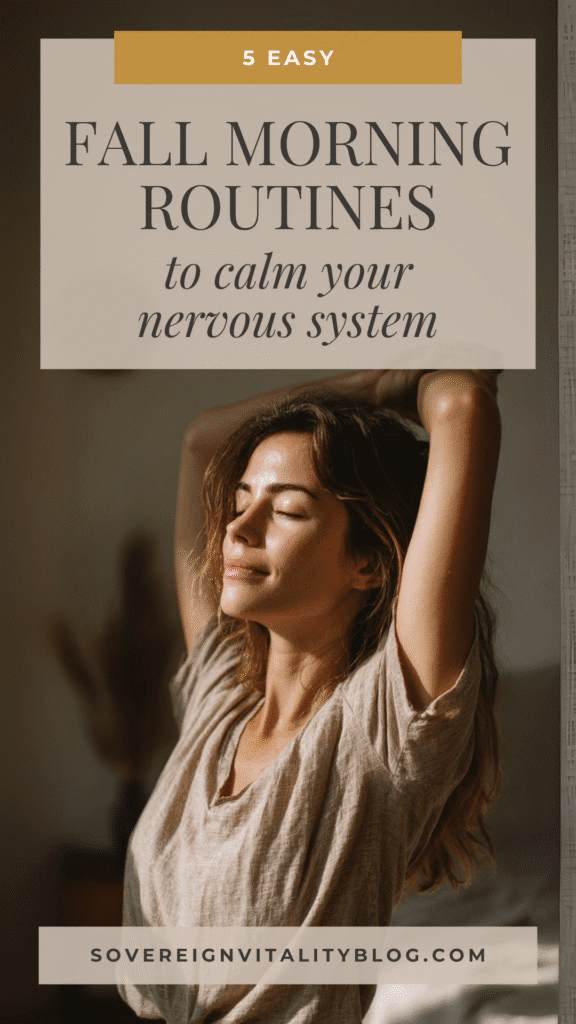This post may contain affiliate links, including those from Amazon Associates. If you make a purchase through these links, I may earn a commission at no additional cost to you. Learn more about our affiliate policy.
On some fall mornings, before the world wakes up fully, I feel that familiar heaviness pulling at my eyelids and shoulders.
There’s an extra weight in the air, chillier mornings, darker skies, and a tug at my nervous system that wasn’t there just weeks ago.
You may have felt something similar, and you’re definitely not alone in this.
Autumn mornings can feel deceptively difficult. Though we’re conditioned to see fall as cozy and restorative, the reality often feels different in our bodies.

Seasonal changes affect our cortisol rhythms, our serotonin levels, and the delicate balance of our nervous systems. It’s natural, and it’s not something you’ve failed to handle properly.
For years, I thought I had to combat fall morning fatigue and anxiety with complicated routines. But through experimentation, I’ve learned it’s often the smallest rituals that ground me most deeply.
Here are five easy fall morning routines I return to each year. They’re simple, soothing, and deeply aligned with the rhythms of the season. I hope you’ll find them just as calming for your nervous system.
1. Step Into Natural Light Within 30 Minutes of Waking

I love the magic of early morning light, so full of possibilities. With shorter days in autumn, it’s tempting to linger under covers or rely on artificial lighting. But I’ve discovered how powerfully even five minutes of natural daylight can shift my mood and energy levels.
Natural morning light helps your body produce cortisol, the hormone that signals it’s time to awaken naturally, and regulates your circadian rhythm, reducing morning grogginess and evening insomnia.
When sunlight touches your eyes early, your internal clock resets gently and beautifully, aligning with nature’s rhythm.
Here’s my invitation to you: within half an hour of waking, open your blinds wide.
Even better, step outside, feeling your feet touch the crisp earth and cool air meet your skin. Notice the shift in your energy when your day begins this way. It’s simple, it’s brief, and it’s transformative.
On especially overcast mornings, I use a Hooga red light therapy device for 10 minutes first thing. Living in a low-light climate, it’s become a quiet essential, lifting my energy and grounding my nervous system when the sun feels far away.
If you’re looking for more simple rituals that restore your calm, you might enjoy exploring my broader collection of 10 Simple Fall Nervous System Routines to Reclaim Your Calm.
2. Begin with a Nervous System Reset Breath

I used to reach for my phone as soon as I woke up, flooding my system with messages and news before my feet even touched the floor.
This habit triggered a subtle sense of overwhelm that persisted all day.
Now, I interrupt this pattern with breathwork, offering my body a few moments of quiet safety instead.
One of my favorite breathing techniques in autumn is the 4-7-8 breath, which softly engages the parasympathetic nervous system.
Simply inhale through your nose for four counts, hold your breath gently for seven counts, and exhale slowly through your mouth for eight counts. Another soothing option is box breathing: inhale four, hold four, exhale four, hold four.
Just a minute or two of intentional breathing before your day begins can lower stress hormones, soothe anxiety, and create a calming foundation. Sometimes, I place a handwritten cue on my nightstand, a reminder of the power and simplicity of breath.
3. Swap Coffee-First for Warm Herbal Support

I adore my morning coffee ritual, yet I’ve learned that caffeine first thing can amplify anxiety, especially during seasonal shifts.
I began experimenting with warm herbal drinks first. It wasn’t about eliminating coffee entirely, just allowing my nervous system space to awaken without additional stimulation.
Herbal teas like lemon balm, tulsi (holy basil), or ginger with honey nourish your adrenal glands and support balanced cortisol levels without jitters.
One of my favorite additions lately has been the Anima Mundi Relax Tonic, a blend of lemon balm, passionflower, chamomile, and ashwagandha that helps soothe the nervous system even before the day begins. A dropperful in warm water creates a soft, grounding start especially when the mornings feel emotionally dense or overstimulating.
Let your morning tea become a sensory practice. Notice the warmth of the mug, the soothing aroma, the subtle shift in your energy as you sip slowly.
4. Ground Yourself With Gentle Movement

There are mornings when fatigue or anxiety feels heavy in your bones, making vigorous movement unrealistic.
Rather than forcing exercise, I began listening more carefully to what my nervous system truly needed: breath-led movements.
Two to five minutes of intuitive stretching, gentle Qi Gong, slow swaying, or simple yoga poses can significantly recalibrate your nervous system.
Movement paired with mindful breathing activates the vagus nerve, softly signaling safety to your body.
My favorite autumn morning movements are uncomplicated: slow shoulder rolls, gentle cat-cow stretches, or standing barefoot and just swaying. Allow your body to guide you.
Let these movements become acts of kindness toward yourself, a slow unfolding rather than another item on your to-do list.
5. Replace Mental Overwhelm With a “Present Moment Anchor”
Anxiety thrives on mental chatter. I’ve found that, especially in autumn when stress can rise internally, creating intentional anchors in my mornings deeply calms my nervous system.
Your anchor could be something simple: lighting a candle, inhaling the scent of lavender or vetiver, or quietly writing down one intention or affirmation. It’s about creating an intentional pause.
This anchor signals safety to your nervous system and grounds your mind in the present.
For me, it often looks like writing my morning pages in my journal, or the slow lighting of a beeswax candle as dawn fills my window.
Choose whatever anchors you most easily and consistently. These tiny practices hold more power than we often realize.
Creating Your Morning Rhythm
As you explore these morning routines, please let go of the idea that you need to adopt all of them or follow each one perfectly. True nervous system care, especially in fall, is about gentleness, not strictness.
It’s about gently aligning your daily habits with the rhythms of nature and the needs of your body.
It’s about choosing presence over rushing, softness over intensity, and small acts of care over perfection.
This season invites us inward to simpler routines, softer rituals, and more meaningful moments of rest. I hope these five rituals help you find a peaceful rhythm as you navigate the shifts of autumn.



